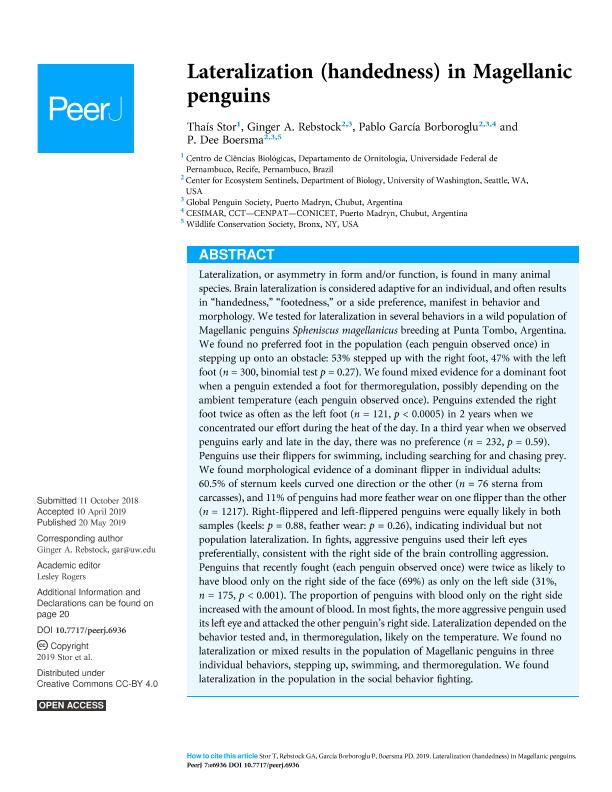Mostrar el registro sencillo del ítem
dc.contributor.author
Stor, Thaís
dc.contributor.author
Rebstock, Ginger A.

dc.contributor.author
Garcia Borboroglu, Jorge Pablo

dc.contributor.author
Boersma, P. Dee

dc.date.available
2019-11-25T21:26:27Z
dc.date.issued
2019-05
dc.identifier.citation
Stor, Thaís; Rebstock, Ginger A.; Garcia Borboroglu, Jorge Pablo; Boersma, P. Dee; Lateralization (handedness) in Magellanic penguins; PeerJ; PeerJ; 2019; 5; 5-2019; 1-25
dc.identifier.issn
2167-8359
dc.identifier.uri
http://hdl.handle.net/11336/90372
dc.description.abstract
Lateralization, or asymmetry in form and/or function, is found in many animal species. Brain lateralization is considered adaptive for an individual, and often results in "handedness," "footedness," or a side preference, manifest in behavior and morphology. We tested for lateralization in several behaviors in a wild population of Magellanic penguins Spheniscus magellanicus breeding at Punta Tombo, Argentina. We found no preferred foot in the population (each penguin observed once) in stepping up onto an obstacle: 53% stepped up with the right foot, 47% with the left foot (n = 300, binomial test p = 0.27). We found mixed evidence for a dominant foot when a penguin extended a foot for thermoregulation, possibly depending on the ambient temperature (each penguin observed once). Penguins extended the right foot twice as often as the left foot (n = 121, p 0.0005) in 2 years when we concentrated our effort during the heat of the day. In a third year when we observed penguins early and late in the day, there was no preference (n = 232, p = 0.59). Penguins use their flippers for swimming, including searching for and chasing prey. We found morphological evidence of a dominant flipper in individual adults: 60.5% of sternum keels curved one direction or the other (n = 76 sterna from carcasses), and 11% of penguins had more feather wear on one flipper than the other (n = 1217). Right-flippered and left-flippered penguins were equally likely in both samples (keels: p = 0.88, feather wear: p = 0.26), indicating individual but not population lateralization. In fights, aggressive penguins used their left eyes preferentially, consistent with the right side of the brain controlling aggression. Penguins that recently fought (each penguin observed once) were twice as likely to have blood only on the right side of the face (69%) as only on the left side (31%, n = 175, p 0.001). The proportion of penguins with blood only on the right side increased with the amount of blood. In most fights, the more aggressive penguin used its left eye and attacked the other penguin's right side. Lateralization depended on the behavior tested and, in thermoregulation, likely on the temperature. We found no lateralization or mixed results in the population of Magellanic penguins in three individual behaviors, stepping up, swimming, and thermoregulation. We found lateralization in the population in the social behavior fighting.
dc.format
application/pdf
dc.language.iso
eng
dc.publisher
PeerJ
dc.rights
info:eu-repo/semantics/openAccess
dc.rights.uri
https://creativecommons.org/licenses/by-nc-sa/2.5/ar/
dc.subject
AGGRESSION
dc.subject
BEHAVIOR
dc.subject
FIGHT ORIENTATION
dc.subject
FOOTEDNESS
dc.subject
HANDEDNESS
dc.subject
LATERALIZATION
dc.subject
MAGELLANIC PENGUIN
dc.subject
SEX
dc.subject
SPHENISCUS MAGELLANICUS
dc.subject
THERMOREGULATION
dc.subject.classification
Ecología

dc.subject.classification
Ciencias Biológicas

dc.subject.classification
CIENCIAS NATURALES Y EXACTAS

dc.title
Lateralization (handedness) in Magellanic penguins
dc.type
info:eu-repo/semantics/article
dc.type
info:ar-repo/semantics/artículo
dc.type
info:eu-repo/semantics/publishedVersion
dc.date.updated
2019-10-22T15:54:27Z
dc.journal.volume
2019
dc.journal.number
5
dc.journal.pagination
1-25
dc.journal.pais
Estados Unidos

dc.conicet.avisoEditorial
This is an open access article distributed under the terms of the Creative Commons Attribution License, which permits unrestricted use, distribution, reproduction and adaptation in any medium and for any purpose provided that it is properly attributed. For attribution, the original author(s), title, publication source (PeerJ) and either DOI or URL of the article must be cited.
dc.description.fil
Fil: Stor, Thaís. Universidade Federal de Pernambuco; Brasil
dc.description.fil
Fil: Rebstock, Ginger A.. University of Washington; Estados Unidos. Global Penguin Society; Argentina
dc.description.fil
Fil: Garcia Borboroglu, Jorge Pablo. Consejo Nacional de Investigaciones Científicas y Técnicas. Centro Científico Tecnológico Conicet - Centro Nacional Patagónico. Centro para el Estudio de Sistemas Marinos; Argentina. Global Penguin Society; Argentina
dc.description.fil
Fil: Boersma, P. Dee. University of Washington; Estados Unidos. Wildlife Conservation Society; Estados Unidos. Global Penguin Society; Argentina
dc.journal.title
PeerJ
dc.relation.alternativeid
info:eu-repo/semantics/altIdentifier/url/https://peerj.com/
dc.relation.alternativeid
info:eu-repo/semantics/altIdentifier/doi/https://doi.org/10.7717/peerj.6936
Archivos asociados
